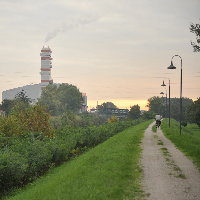Direct and Indirect Information in Urban Space Planning
Abstract
The relationship between new technologies and urban space has become, especially with the introduction of the concept of smart city, the key in the definition of management options in the city itself.The opportunities provided by the use of new technologies to manage the complexity of multiple aspects on the relationship between city and people can address strategies and innovation in order to improve the quality of life of the inhabitants. In smart cities different groups of people with different instances can be directly involved in the transformation process and the planners’ choices can be supported by information that once would have required costly research. This possibility is granted by the availability of great quantities of data that can be collected and analyzed. Direct information can be gathered by multiple sensors (accelerometer, a geomagnetic sensor, and proximity sensor, etc.) that offer an immediate evaluation of a specific phenomenon. At the same time other aspects can be evaluated by information obtained in social networks: these can contribute to the definition of urban design as the result of a multi criteria analyses. The way to achieve these strategies is a process of interaction between spatial reality and perceived reality made available by passive forms of participation that can help planners in understanding territorial actors’ / territorial users’ needs and requirements.
Through this approach, the design and decisions about urban space are not to be indifferent to the needs expressed by various categories of population.
Downloads
References
Alexander C., A Pattern Language: Towns, Buildings, Construction, Oxford University Press, Oxford, 1977
Amin A., Thrift N., Città. Ripensare la dimensione urbana, Il Mulino, Bologna, 2005
Beguinot C., U. Cardarelli (a cura di), Per il XXI secolo una enciclopedia. Città cablata e nuova architettura, Università degli Studi di Napoli "Federico II" (Di.Pi.S.T.), Consiglio Nazionale delle Ricerche (I.Pi.Ge.T.), Napoli, 1992
Boschetto P., Schiavon A., L’immagine del territorio metropolitano. La città metropolitana di Padova, Cleup, Padova, 2011
Bronzini F., M. A. Bedini, S. Sampolesi, La città amica di Roberto Busi, Ancona University Press, Ancona, 2011
Carmona M., Sieh L., Measuring quality in planning. Managing the performance process, Spon Press, New York, 2004
Detragiache A., a cura di, Dalla Città Diffusa alla Città Diramata, Milano, Franco Angeli, 2003
Giedion S., Spazio, tempo architettura, Hoepli editore, Milano, 1984
Haas T., a cura di, New urbanism and beyond. Designing cities for the future, Rizzoli International Pubblications, New York, 2008
Jacobs J., Vita e morte delle grandi città. Saggio sulle metropoli americane, Einaudi editore, 2009
Koolhaas R., B. Man, S, M, L, XL, Monacelli Press New York, 1995
Istituto Nazionale di Statistica – ISTAT, I cittadini e il tempo libero, 2010
Istituto Nazionale di Statistica – ISTAT, Lo sport che cambia. I comportamenti emergenti e le nuove tendenze nella pratica sportiva in Italia, 2005
Lynch K., L’immagine della città, Venezia, Marsilio, 1964
Mitchell W. J., La città dei bits, Electa, Milano, 1997
Ratti, C., Pulselli, R.M., Williams, S. & Frenchman, D. (2006) Mobile Landscapes: Using Location Data from Cell Phones for Urban Analysis. Environment and Planning B, 33, 5, pp. 727- 748
Ratti, C., Baker, N. & Steemers, K. (2003) Urban Infoscapes: New Tools to Inform City Design and Planning. ARQ – Architectural Research Quarterly, 7, 1, pp. 63-74.
Piroddi E., Le regole della ricomposizione urbana, Franco Angeli editore, Milano, 2000
Pulselli, R.M., Ratti, C. & Tiezzi, E. (2006) City out of Chaos: Social Patterns and Organization in Urban Systems. International Journal of Ecodynamics, 1, 2, pp. 125-134
Sassen S., Una sociologia della globalizzazione, Einaudi, Torino, 2008

Copyright (c) 2014 Tema. Journal of Land Use, Mobility and Environment

This work is licensed under a Creative Commons Attribution 4.0 International License.
Authors who publish in this journal agree to the following:
1. Authors retain the rights to their work and give in to the journal the right of first publication of the work simultaneously licensed under a Creative Commons License - Attribution that allows others to share the work indicating the authorship and the initial publication in this journal.
2. Authors can adhere to other agreements of non-exclusive license for the distribution of the published version of the work (ex. To deposit it in an institutional repository or to publish it in a monography), provided to indicate that the document was first published in this journal.
3. Authors can distribute their work online (ex. In institutional repositories or in their website) prior to and during the submission process, as it can lead to productive exchanges and it can increase the quotations of the published work (See The Effect of Open Access)
